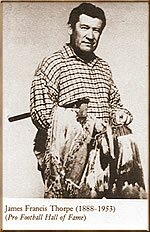Jim Thorpe
(1888-1953)

Click on the image for a larger view
James Francis Thorpe, Wathohuck, or “Bright Path,” and his twin brother Charles were born near Prague, Oklahoma on May 28, 1888. Their father was Hiram Thorpe, a half-Sauk-Fox Indian and half-Irish farmer, and their mother was Charlotte View, the part-French granddaughter of the Sauk chief Black Hawk. The two boys were raised on a farm and lived and played in the outdoors, until Charles died at the age of nine. Young Jim was educated at the Sauk-Fox Reservation School and at Haskell Institute, before going on in 1904 to Carlisle Indian School. At that time the athletic coach was the great Glenn S. “Pop” Warner, who subsequently went on to coach at Pittsburgh, Stanford, and Temple Universities.
Warner recognized the inherent ability of the young man, and developed his talents to the point where Thorpe and his teammates defeated the best collegiate teams of the day, including Harvard, Army, and Pennsylvania. Thorpe was far more than just a fine football player. He was an all-round athlete and spent two summers playing semi-professional baseball. Under Warner’s tutelage, he prepared for the 1912 Olympic track and field contests. At the Stockholm games he stunned the Western world by winning both the pentathlon and the decathlon, a feat never accomplished before or since. King Gustav of Sweden presented him with a trophy and called him “the greatest athlete in the world.”
But in 1913, the Amateur Athletic Union virtuously pointed to his semiprofessional baseball activity and revoked his amateur standing. “I was simply an Indian schoolboy, not wise to the ways of the world,” Thorpe wrote the AAU. “On the same teams I played with were several college men . . . all considered as amateurs.” The simon-pure AAU made no allowance for naïveté however, and ordered him to return all Olympic medals and trophies—the greatest feats of the century were thus expunged from the Olympic record books.
Thorpe joined the New York Giants; unfortunately, he never learned to hit a curve ball and ended his baseball career in the minor leagues in 1919. The next year, at the age of 32, he helped organize the American Professional Football Association, and played for the Canton (Ohio) Bulldogs. He was still a spectacular attraction for the fans, and his team went undefeated in 1922 and 1923. “If he were playing today,” remarked one contemporary sportswriter, “Thorpe would be as rich as Joe Namath.” But those were easier times, and Thorpe was a happy-go-lucky, hard-living “good sport,” rather similar in personality to his near-contemporary, Babe Ruth. When he left professional football in 1929, he was far from wealthy.
The Thorpe name lived on, but the man himself fell into obscurity and hard times. He made occasional celebrity appearances and had a few stunt roles in the movies, but his athletic career had begun a slow decline. In 1937 he returned to Oklahoma and took part in Sauk-Fox tribal matters, opposing the new constitution that many Indians felt gave too much power to the federal government.
In the early 1940s he was a popular lecturer and in 1945 he joined the Merchant Marine. After the War, he was in California where the biographical motion picture, Jim Thorpe—All-American, was produced in 1950-1951. He died at the age of 64 in Lomita, California on March 28, 1953, and was buried near Carlisle Institute. Thorpe married three times—to Iva Miller, then Frieda Kirkpatrick, and lastly to Patricia Gladys Askew; in all, he had eight children. Physically, he was a large man, 6’11” tall, weighing 188 pounds.
In 1954, the towns of Mauch Chunk and East Mauch Chunk, in Pennsylvania, united and were renamed Jim Thorpe. In 1955, in his honor, the National Football League established the Jim Thorpe Memorial Trophy as a most valuable player award. Ironically, 20 years after his death, the AAU relented and replaced his records in the Olympic books.
An Associated Press poll of sportswriters in 1950 ranked Jim Thorpe as the “greatest American athlete of the first half of this century” . . . a fitting tribute to this magnificent Sauk sports champion.
Source: Great North American Indians by Frederick J. Duckstander